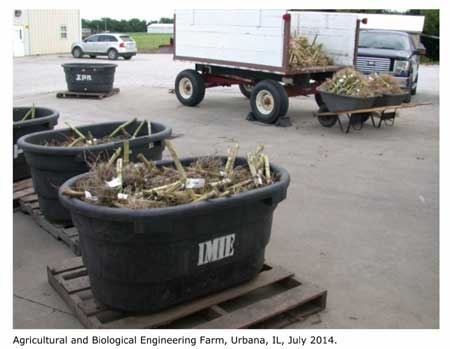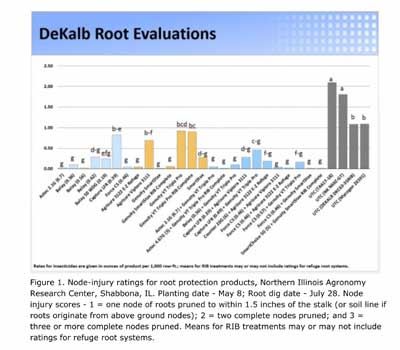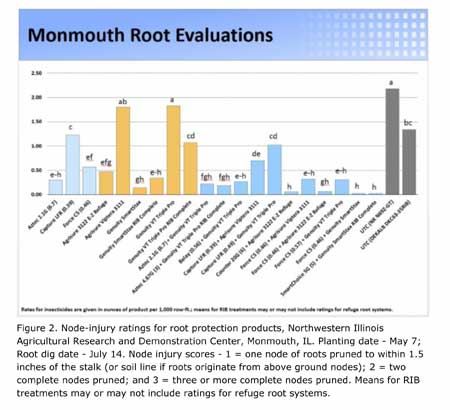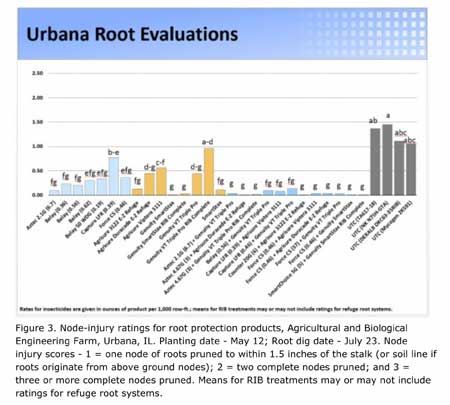|
Preliminary Corn Rootworm Injury Evaluation Results From Illinois’ Trials 2014
DR. MICHAEL GRAY
URBANA, ILL.
In late July, the annual University of Illinois root “digs” and corn rootworm product evaluation trials were completed. Each experiment was established on plots that had been planted to a trap crop (late-planted corn interplanted with pumpkins) in 2013. The results for three of these studies are presented in the following bar graphs. The charts are arranged with the soil insecticide only treatments appearing in light grey, Bt hybrid only products are marked with a (/), Bt hybrids combined with soil insecticides represented with a (x), and the untreated checks shaded in dark gray. Treatment bars that share the same letter do not differ statistically (P=0.05).

Most rootworm protection products at the Northern Illinois Agronomy Research Center (DeKalb), were able to keep root injury below 0.5 (1/2 node pruned). Products that resulted in root injury that exceeded this level included: Capture LFR (0.83), Agrisure Viptera 3111 (0.69), Genuity VT Triple Pro (0.92), and Genuity VT Triple Pro RIB Complete (0.9). These treatments were not statistically different from two of the untreated checks. The Agrisure Viptera 3111 treatment expresses the mCry3A rootworm protein along with some other proteins (Cry1Ab, Vip3A) designed to provide lepidopteran control. The Genuity VT Triple Pro and Genuity VT Triple Pro RIB Complete treatments express the Cry3Bb1 rootworm protein as well as some other Bt proteins (Cry1A.105, Cry2Ab2) for lepidopteran pests. With respect to the checks, three were treated with insecticidal seed treatments: NK N69Z-GT – Cruiser 500; DeKalb DKC63-35RIB – Poncho 500, and Mycogen 2K591 – Cruiser 250. Seed for the TA617-18 check does not have any insecticidal treatment.
Overall pressure in the DeKalb trial was good with approximately two nodes of roots pruned in two of the check treatments. Under this level of injury, the root protection afforded by Bt hybrids expressing only the Cry3Bb1 protein was not stellar. With the exception of Capture LFR, the soil insecticide (only) treatments offered very good levels of root protection. Overall, the combined use of a planting-time soil insecticide and a Bt hybrid did not statistically improve root protection over that of a soil insecticide used alone.

The past few seasons, corn rootworm injury at the Monmouth location has been low and difficult for us to effectively evaluate product performance. In 2014, root injury in one of our checks (NK N69Z-GT, treated with Cruiser 500) exceeded two nodes (2.18) of roots destroyed. The other check (DeKalb DKC63-35RIB, treated with Poncho 500) had less root injury (1.34). Most of the root protection treatments in Monmouth keep root injury below 0.5 (1/2 node pruned). However, root pruning in several treatments exceeded 1.0 (one node pruned) and included: Capture LFR (1.23), Agrisure Viptera 3111 (1.8), Genuity VT Triple Pro (1.83), Genuity VT Triple Pro RIB Complete (1.07), and Capture LFR + Genuity VT Triple Pro (1.02). Root protection afforded by Agrisure Viptera 3111 and Genuity VT Triple Pro was not statistically different from the untreated check (NK N69Z-GT) and use of both treatments resulted in nearly 2 nodes of roots destroyed. Resistance to the Cry3Bb1 protein has been confirmed in several northwestern Illinois counties and cross resistance with this protein to the mCry3A protein has been confirmed in Iowa. Although not confirmed, it seems possible that the resistant western corn rootworm strain may have affected the performance of these treatments within this trial.


As compared with the DeKalb and Monmouth experiments, the overall root injury in the Urbana study was lower with the four checks ranging from approximately 1 to nearly 1.5 nodes of roots pruned. Even with this moderate pressure, root injury in the Capture LFR (0.78) and Genuity VT Triple PRO RIB Complete (0.96) treatments approached one node of roots pruned and were statistically similar to several of the untreated checks. Root injury in the other treatments was generally below 0.5 (1/2 node pruned).
Root ratings were not presented for the Orr Agricultural Research and Demonstration Center located near Perry Illinois due to the low overall injury in the untreated checks (0.29 to 0.76). Each of these experiments, including the Orr site, will be harvested later this fall. A final report of the root injury ratings and yields will be published in the on Target Report. This report also includes product performance summaries for previous years going back to 2004.
I offer my thanks to Ron Estes (Principal Research Specialist in Agriculture, Department of Crop Sciences) and Nick Tinsley (Postdoctoral Research Associate, Department of Crop Sciences) for their important leadership in all aspects of this research. ∆
DR. MICHAEL GRAY: Crop Sciences Extension Coordinator & Assistant Dean for ANR Extension Programs/Professor, University of Illinois
|
|